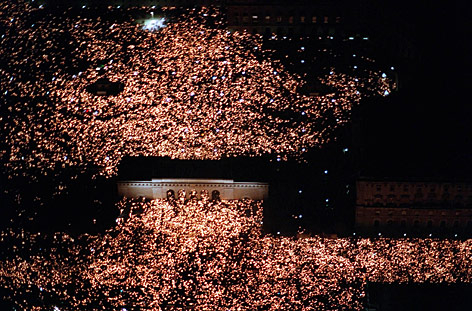Heldenplatz
Highly symbolic square
Heldenplatz is located at the heart of institutional Austria and the important offices of the state: the President’s Office, the Chancellor’s Office and the Foreign Ministry. Heldenplatz is a large square that lies between the Hofburg Palace and the Ringstrasse and was originally designed for parades, but also as a place of symbolic representation.
Heldenplatz before 1945
There is nowhere else in Austria where the history of the past one hundred years is writ so clearly: WW I (1914-1918), the abolition of the monarchy, the First Republic and Austro-fascism (1918-1938), to the political and moral capitulation of the Anschluss to the German Reich (1938) and the liberation by Allied troops and the foundation of the Second Republic, which has continued from 1945 until today.
It was a conscious decision to use this historically "loaded" square for the Nazi propaganda purposes, as Adolf Hitler stood on the balcony at the Hofburg and announced the annexation of Austrian to Nazi Germany. The square remains a symbol of the enthusiasm and support of a large part of the Austrian population for the Anschluss in the collective memory of Austria.
Heldenplatz after 1945
After 1945, Heldenplaz continued to be used for – albeit very different – large events. Just 20 years later, the first political victim of the Second Republic, Ernst Kirchweger, a concentration camp survivor, died of injuries he sustained at the demonstration against the unrepentant Nazi, Taras Borodajkewycz. On the day of his funeral, a memorial event on Heldenplatz was attended by 30,000 people. The largest demonstration of the Second Republic was the "Lichtermeer" (See of Lights), on 23rd January 1993, when more than 250,000 people gathered to protest the xenophobic politics of Jörg Haider FPÖ.
23rd January 1993, "See of lights" at Vienna’s Heldenplatz:

The Heldenplatz has also featured in various cultural and artist representations of the city. The most famous example is the play "Heldenplatz" by Thomas Bernhard. The premiere on November 4th 1988 in the Vienna Burgtheater became a media and cultural-political scandal – particularly as it coincided with the so-called "Bedenkjahres" (50th anniversary of the Anschluss).
Also important to the meaning of Heldenplatz is the capitulation of the German Wehrmacht on May 8th 1945, bringing an end to WWII. Beginning in the 1990s, extreme-Right fraternities held commemorations for "their" fallen heroes, soldiers and members of the Nazi criminal organisations in front of the crypt in the right wing of the Burgtor. In protest at this revisionist perspective, demonstrations were held regularly throughout the 2000s by people who wished to celebrate the victory over the German Wehrmacht and not mourn it. The debate was particularly intense in 2002 as Right-wing groups held protest events on Heldenplatz against the exhibition "Crimes of the Wehrmacht".
In the years following, May 8th lost none of its controversy. The counter demonstrations continued to grow and Heldenplatz was split in order to accomodate the protests. For the 68th anniversary of the liberation of Austria from National Socialism in 2013, the Austrian army held the first vigil and was able in this way to finally keep the controversial commemoration of the Vienna Korporationsring (WKR) away from the crypt. The same year also saw the first ever "Festival of Joy" – a free concert of the Wiener Symphoniker, organised by the Austrian Mauthausen Committee, to mark the end of the Nazi regime in a more appropriate way.






